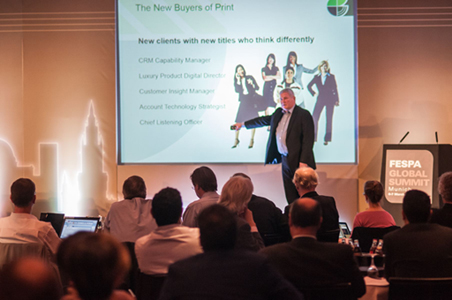We’re doing well, but we can do better according to Fespa Global Summit speakers. Here’s the upshot of the two-day event.
Technology is driving convergence. And so is customer expectation. If there was one key takeaway from the recent Fespa Global Summit, it was that what we fear should be what we embrace. That we’ve got to get beyond the mindset of being a ‘printer’ and think about how we can become specialists in visual communication, whatever that might entail.
Christian Duyckaerts, MD of Belgium-based Retail Communications told the international audience how, in partnership with KL Druck in Germany and Augustus Martin in the UK, the operation handles everything from conceptual retail project design including analysis of a retail store environment, wood and metal store display fabrication, space rebuilds/refits (including electrics) through to print and installation. “We work with really big brands where the involvement is way beyond printing POS and there’s more to come,” he enthused.
Becoming a ‘solutions’ business is hardly a new idea - there’ve been plenty of stories in this magazine that attest to that - but that doesn’t mean the job’s done. The upcoming Image Reports’ annual Widthwise Report 2014 will show that there’s still plenty of scope for diversification into what are yet very small but potentially enormous print markets, never mind expansion into areas like data management and analysis, an area that keeps getting flagged up at seminars etc. as ripe for PSP involvement.
So what are the sticking points? Across two separate talks at the summit Neil Falconer of consultancy firm Printfuture reiterated what you probably already know, but what a lot have yet to act upon. “We have clients that are doing phenomenally well, with some small companies punching way above their weight because they have good strategy for growth,” said Falconer, “but we also see many blocks to success within the print sector.
“For a start we are not educating customers well enough to create new demand from new areas. We need to understand potential customer needs so that when the time is right that can be converted to sales. But that means doing homework. When was the last time you went to one of your customer’s market shows, be it in the finance sector, biomedical – whatever? You need to know what’s going on in your customers’ space not just in print. You need to know what ‘trigger events’ are taking place so that you can use them to your advantage.
“The bottom line is that many printers don’t understand their customers or the markets they operate in. They don’t know the value of business research or have an intelligence gathering process in place.”
He added: “The weaknesses we see in companies are a lack of: high quality professional management; strategic direction and business planning; e-commerce capability; modern sales process; and focus on skills development.
“We have a high tech manufacturing and fulfillment capability but the sector continues to face massive change. We really need to start marrying the strengths and weaknesses we have with the opportunities and threats we face. Successful businesses will be marketing/IT led, generators of business outcomes and solutions, manage data and supply analysis and be an advisor to clients on market intelligence and technology deployment. This stuff isn’t difficult, it’s just different – it’s no harder than understanding colour management, there just needs to be an openness to learn.”
And to teach. One of our biggest weaknesses as an industry sector could well turn out to be our biggest opportunity if we pull together a cohesive education/branding programme that shows the world at large what wide-format print is capable of.
Mark Cruise, head of print management, BSkyB, said at the summit quite blatantly: “The customer doesn't know what you can do. Come to us with innovations, but don’t come and tell us what your printer can do. Tell us how you can help us.”
With 20 years’ experience as an ad agency creative and chief, Wrage/Antwort founder and owner Folker Wrage recognised that this shift in emphasis can be difficult, especially if business is currently quite buoyant as is the case with many large-format digital printers, but added: “I’ve learned that when the rate of change on the outside exceeds the rate of change on the inside, the end is in sight. Sometimes it’s difficult to implement change when the shit hasn’t hit the fan yet. But who wants to get hit with the shit?”
At the summit various creative/designers spoke about how they are using the medium, but the messaging included a call for the print community to better engage with them, and as Karin Langeveld of Trapped in Suburbia said, “brainstorm, experiment, play and be curious”.
{jathumbnail off}


